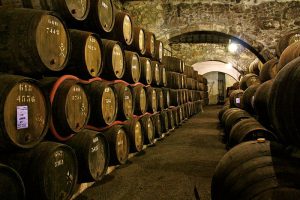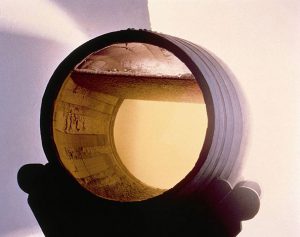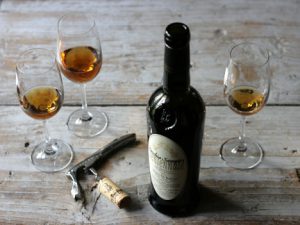With cold days and colder nights in the heart of winter, we wanted to address the topic of fortified wines.

Port Wine Cellars
We offer this fortified wine primer to get you started on your fortified wine journey. This is an introduction to the category, so naturally, many generalizations are made. We hope that this kickstarts your exploration of fortified wines.
What are fortified wines? Sometimes, the name tells you everything.
A fortified wine is a wine that is fortified with the addition of a distilled spirit. The addition of spirit increases the strength of the alcohol, halts any fermentation, and partially preserves the wine. Popular fortified wines include Port, Sherry, Marsala, Madeira, and aromatized wines such as Vermouth. Aromatized wines are fortified wines that have been flavored with herbs, spices, or other plant-based flavors.
Fortified Wines of the World
Port – as the name might suggest, Port is made in the nation of Portugal, specifically in the Duoro Valley. Port is made by fortifying wines that have not yet been fully fermented with an unaged Brandy. As the wines have not finished fermentation, the natural sugars are locked in the Port wine.
There are numerous styles of Port, ranging from sweet Ruby Ports to nutty and sometimes dry Tawny Ports, fancy Vintage Ports, and the less common White Port. Tawny Ports are frequently bottled with an age statement ranging from 10 years to 40 years, indicating the time in cask. The older the tawny, the drier the wine, and the higher the price tag. Vintage Ports are typically the most expensive of all being made in ideal years when a “vintage” is declared. These Ports can age in your cellar for decades.

Sherry Wine “flor”
Sherry – is made exclusively in Andalusia, Spain, near the city of Jerez de la Frontera. Unlike Port, Sherry is frequently bone-dry, offering many styles ranging from dry to sweet.
There are two fundamental types of Sherry, Fino, and Oloroso, from which many variations are spawned. The primary difference between these two basic types is the “flor.” Flor is a protective film that develops spontaneously from air-born indigenous yeasts on the surface of the wine. Wines destined to be Fino are typically fortified to 15.5%, while Oloroso is fortified to 17% and above.
Fino and its sub-type, Manzanilla, are quite dry and are served cool as an aperitif. Amontillado (in simple terms) is an aged Fino that takes on nutty and somewhat sweet notes thanks to concentration by evaporation. Oloroso is typically richer and sweeter, with many wood accents offering roasted nuts and toffee flavors. On your store shelves you have likely seen Cream Sherry. These Sherries are often sweetened Oloroso and are served after dinner or sipped in the afternoon by plucky grandmothers everywhere.
Madeira – is made exclusively in Portugal’s Madeira Islands. Madeira is prized for its rich and pleasingly oxidized flavors. The classic Madeira flavor profile was originally achieved by sending barrels of Madeira on long sea voyages through tropical climates. Today, the same effect is accomplished by gently heating the wines and aging them in wood casks. Cheap Madeira is made quickly with high heat applied, while the best Madeira requires decades of maturation.

Sicily’s Marsala Wine
Marsala – is Italy’s world-famous fortified wine. It is made on the Island of Sicily near the city of Marsala. Marsala was granted official DOC status in 1969 and the European Union protect the name. Several styles of Marsala are frequently classified by color, sweetness, and time aged in cask. Sweetness levels range from Seco (the driest) to Semisecco (medium sweet), and finally Sweet (the sweetest Marsala). Color ranges from golden to ruby, and age designations range from Fine, aged one year, to Vergine e/o Soleras Riserva that are aged at least 10 years.
Commandaria – is made on the Island of Cyprus from indigenous grapes. This ancient style of fortified wine is believed to date back to 800 BC or before. Commandaria is made from over-ripe grapes resulting in a sweet and strong wine before the addition of an unaged grape-based distillate.
Vermouth – is much more than an essential ingredient in the Martini or the Manhattan; it is a beautiful style of fortified wine from Italy. As most of you know, Vermouth is typically classified as being either dry (or bianco) or sweet (rosso). Vermouth is made with a dry wine base with the addition of an unaged Brandy and a proprietary blend of aromatic botanicals. Depending on the style, a dose of sugar may also be added. Vermouth is used in a number of classic cocktails, but in its native Italy, it is frequently sipped neat, chilled, or over ice.
Pineau des Charentes – can be a fortified wine as a low alcohol wine made from grape must (pressed fruit) is blended with an unaged Cognac (eau-de-vie). However, there is frequently no wine in the Pineau des Charentes, rather unfermented grape juice with eau-de-vie.
This concludes our fortified wine primer. Each style has many details to explore, and we encourage you to dive into this diverse category that straddles both the wine and spirits world.

Good summary Sean – he says sipping a glass of ‘Ten Year Old Tawny’ – Trader Joe’s $11.99 good value contribution to the decent Port available here in the States… I’ve always liked good Port, although I’ve never been able to justify to myself paying the exorbitant prices usually charged for the decent stuff !
Great read, Sean. There is a winery in North Carolina that makes a Pineau using Traminette juice mated to Chardonnay brandy that they can’t make fast enough.
I’m going to have to find a bottle of this Pineau!